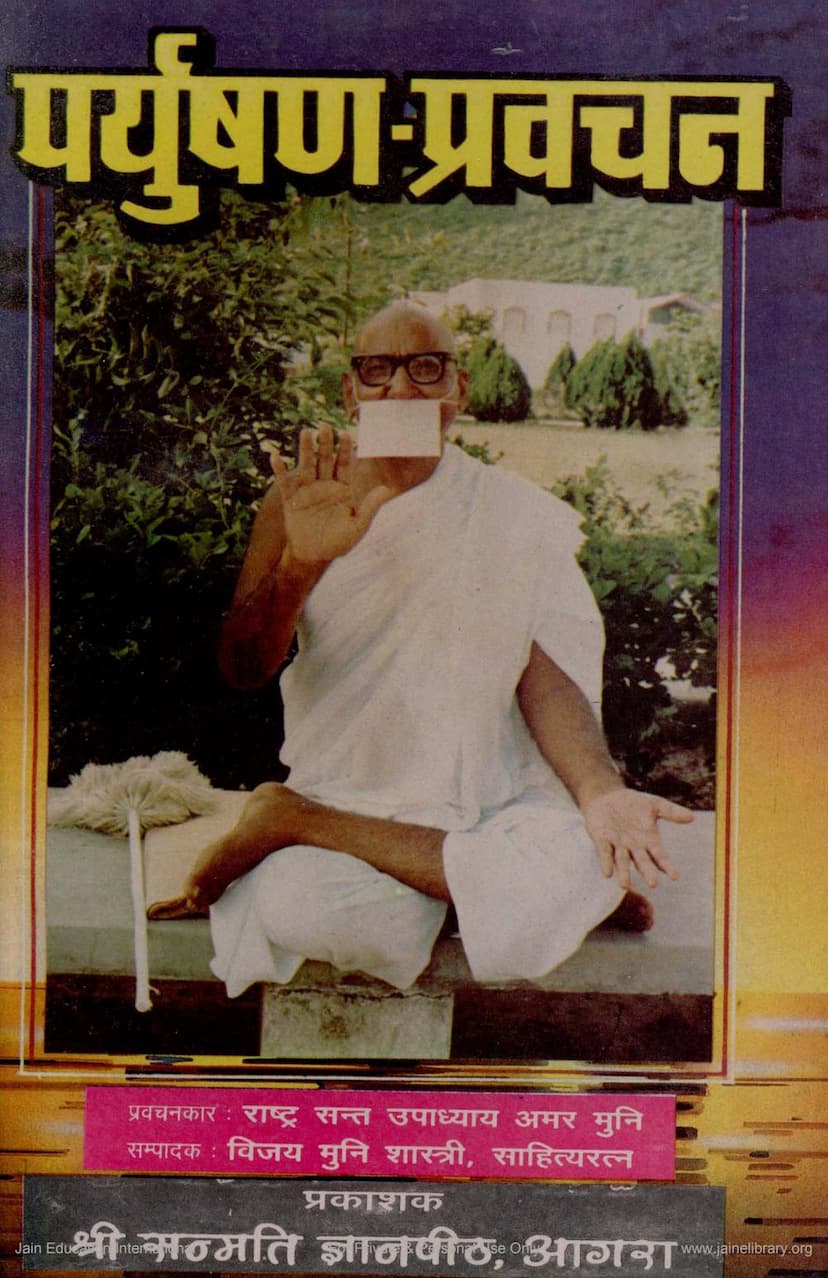Paryushan Pravachan
Added to library: September 2, 2025

Summary
This Jain text, titled "Paryushan Pravachan" (Discourses on Paryushan), is a compilation of sermons delivered by Rashtra Sant Upadhyay Amarmuni. Edited by Vijay Muni Shastri, Sahityaratna, and published by Shri Sanmati Gyan Pith in Agra, the book offers profound spiritual guidance focused on the significance and observance of the Paryushan festival, a major Jain observance.
The preface to the second edition highlights that Paryushan is a highly revered festival in Jainism, considered eternal by some and initiated by Lord Mahavir by others. The eight days of Paryushan are marked by renunciation of worldly pleasures, adoption of a more spiritual path, fasting, adherence to strict vows and discipline. People of all ages gather to listen to scriptures, engage in self-study, meditation, and discussions on dharma and knowledge. Generosity and compassion are emphasized during these days.
The book draws upon discourses given in various locations like Calcutta, Agra, Alwar, and Jaipur, which are based on the Antakrit Dashang Sutra. It acknowledges the possibility of repetition due to the compilation of lectures from different places, but notes the effort to minimize it. The preface also clarifies that while Paryushan is observed for eight days with recitations of Antakrit Dashang and Kalpa Sutra in the Shvetambar tradition, it differs in the Digambar tradition.
The introduction emphasizes the core message that human upliftment and downfall originate from within, stemming from one's thoughts and actions. It stresses the importance of transforming thoughts into actions, aligning with the philosophy that "As a man thinks in his heart, so he is." The text delves into the dual aspects of human existence: the mortal (physical body) and the immortal (soul). It calls for the awakening of the immortal essence within the physical form through self-reflection and spiritual practices.
The book outlines the essence of Paryushan as a period for introspection, self-purification, and spiritual growth. It explains the meaning of "Paryushan" as "to remain near the soul," encouraging a shift from materialism to spirituality, from delusion to right faith, from attachment to equanimity, and from ignorance to right knowledge. The text emphasizes the importance of cultivating four Bhavanas (sentiments): Maitri (friendship towards all living beings), Karuna (compassion for the suffering), Mudita (joy in the happiness of others), and Upeksha (equanimity towards faults).
The book further categorizes life into three types: Asuri (demonic), Daivi (divine), and Adhyatma (spiritual), advocating for the pursuit of the spiritual path, which is rooted in non-violence, self-control, and austerity. It highlights the importance of self-reliance, self-knowledge, and self-control for spiritual development, defining spiritual life as based on Samyagdarshan (right faith), Samyagjnana (right knowledge), and Samyak Charitra (right conduct).
The text also provides insights into the duties of monks and lay followers during Paryushan. For monks, it includes confession (Pratikraman), head-shaving (Keshloch), austerities, confession of faults, and forgiveness. For householders, it involves listening to scriptures, fasting, practicing non-violence (Abhay-dan), giving to the deserving (Supatra-dan), observing celibacy, renouncing harmful activities (Aarambh tyag), serving the community (Sangh seva), and seeking forgiveness.
The book then discusses various figures and concepts within Jainism, including:
- Gautam Kumar: Presented as an example of detachment and renunciation, who despite a pampered upbringing, embraced asceticism after hearing Lord Neminath's discourse. His life illustrates the power of inner resolve and the transformative impact of spiritual teachings.
- Shri Krishna: Portrayed as a revolutionary leader and karmayogi, whose life demonstrates resilience in adversity, the importance of inner strength over external circumstances, and the balance between compassion and the need for righteous action. His teachings, especially from the Bhagavad Gita, are highlighted as guiding principles for facing life's challenges.
- Gaj Sukumar: A young prince whose detachment and spiritual fortitude are emphasized, especially through his challenging practice of asceticism. His life story serves as an inspiration for overcoming worldly attachments and facing hardships with equanimity.
- Atimuktak Kumar: A young prince whose spiritual awakening and subsequent renunciation, even at a young age, highlight the power of early spiritual inclinations and the potential for profound transformation. His journey demonstrates how deep understanding and conviction can override familial and societal pressures.
- Sudharshan: His fearless act of facing the violent Arjun Mali unarmed, demonstrating the supreme power of love, compassion, and inner strength over brute force, is presented as a testament to the triumph of righteousness.
- Nari-Jeevan (Women's Life): The text celebrates the significant role of women in Indian culture, particularly in Jainism, as embodiments of love, forgiveness, and renunciation. It contrasts the spiritual strength of women like Kali and Mahakali with the superficiality of valuing women based on material possessions, emphasizing that true worth lies in inner virtues.
- Marg aur Manzil (Path and Destination): This section emphasizes self-reliance and inner exploration, asserting that the ultimate truth and divine potential lie within oneself rather than being sought externally. It encourages the identification and realization of one's true self.
- Parvo ka Sandesh (Message of Festivals): This chapter discusses the evolution of festivals from a state of nature-dependence to a focus on human effort and responsibility, culminating in collective celebration and spiritual elevation. It stresses that festivals are not merely for remembering the past but for shaping the present and future.
- Samatva-Yog (Equanimity Yoga): This section underscores the inherent divinity within every human being and advocates for the cultivation of inner virtues and self-awareness to realize one's true potential, transcending petty conflicts and worldly divisions.
- Aavashyakta aur Trishna (Need and Craving): This chapter differentiates between essential needs and insatiable cravings, highlighting how the latter leads to downfall. It emphasizes the importance of controlling desires and cultivating detachment through righteous actions and right perspective.
The book's overall message is one of spiritual awakening, ethical conduct, self-reliance, and the pursuit of liberation through self-discipline and virtuous living, all within the framework of Jain philosophy and the observance of Paryushan.